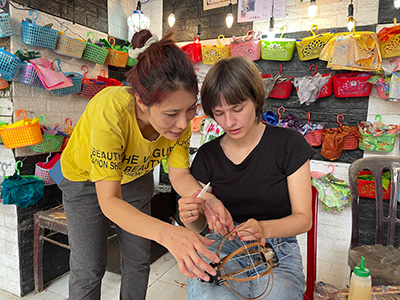

Unique craft workshop in Hoi An: Create your own lantern with the Lantern Lady
Looking for a creative and IMPACKTful travel idea in Vietnam? Then I highly recommend you stop by The Lantern Lady named Thuy in Hoi An. Here you'll learn about the craftsmanship and history of Hoi An's UNESCO World Heritage Old Town. With Thuy's assistance, you'll build your own traditional lantern, perfect as a souvenir from your sustainable slow travel trip. Find out how the workshop works, what the talented lantern lady told me and what the Festival of Lights is all about.
Festival of Lights: A beautiful sea of lights
When my friend Flo and I stroll through Hoi An for the first time, we are thrilled by the old town and the lanterns. The lanterns play an important role in the traditional celebrations, especially the Festival of Lights, which is what we came for this evening. The Festival of Lights is celebrated every full moon, or the 14th day of each lunar month. During this time, the city is bathed in a beautiful sea of lights from glowing lanterns - simply magical.
UNESCO World Heritage Old Town Hoi An: A Journey through Time and Cultures
Lantern Paradise: Local, authentic, creative

Arriving in the small alley in front of Thuy's store, we are warmly greeted by the Lantern Lady. Her store is full of colorful lanterns hanging from the ceiling like beads on a necklace. Below them are small tables surrounded by plastic chairs. A good sign - like street food. Because if there are small plastic chairs or stools, it is in all likelihood local and authentic. So we settle down on them and want to get started right away.
Travel activity à la Slow-Travel
"How much time did you bring?" asks the Lantern Lady, "If you want to build the frame yourself, it will take about 90 minutes." "We're Slow Travelers," I say with a laugh, "We have all the time in the world." So we opt for the longer option at the equivalent of €5.50 per person.
Sustainable materials
Thuy is an inspiring personality who understands the importance of sustainability in her business. While tinkering, I ask Thuy why exactly we are using bamboo. Thuy explains to me that it's nice and light as well as durable - so it's perfect for crafting and bending. The flexibility of bamboo means the finished lantern can be folded for easier transport and storage.
That being said, the material here is easy to find everywhere. Thuy collects it himself from the surrounding area. Pretty handy. Fun fact: There is no other plant on earth that grows faster in height than bamboo! For the holders, she prefers to use local woods like mango or jackfruit. Not only is it sustainable, but it's also cost-effective and strong enough to hold the shape of the lantern.
Tourism full of IMPACKT

Thuy has been in the lantern-making business for more than 10 years, and her passion for her craft is unmistakable. She is proud to share her craftsmanship with others. "I want to show people my tradition because it is so hard," she says with a smile. "I love lanterns because they are handmade. I love working here," she adds, her eyes shining with enthusiasm. She explains that tourism and the sale of the lanterns allows many women to switch from hard farm work to making lanterns. "There are fans here," she jokes, asking us to take a seat next to her at a small table.
Instructions for a traditional lantern
At the workshop, I first choose the design and size of the lantern. I decide on a small, round version. Perfect to fit in my IMPACKT suitcase. Then I get to bend the bamboo strips for the framework. For this, I press the bamboo strips against a cut thick bamboo tube until Thuy is satisfied. By the way, it looks easier than it is. When I'm done with that, I attach a wooden holder to both ends of the bamboo strips with wire. This gives the lantern the right round shape. So far so good. Then I stretch strings between each bamboo strip and tie them tight before gluing the fabric on top. "It's still too loose," Thuy tells me, calmly showing me how to tighten it, "otherwise the fabric won't look nice later." Then I coat the bamboo framework with glue. Then I lay the fabric on top and press it down. A few minutes later, I trim off the overlaps before choosing a color-matching cord for the final detail. Finally, Thuy and I take a photo together with my work of art.
I'm incredibly proud of my homemade lantern and think it's much nicer than the ones in the souvenir stores. When it comes to real craftsmanship, mass production just can't compete, can it? This also makes me think of the weaving art of the indigenous Black Hmong people of northern Vietnam and Mama Zuzu. Similar to Thuy, Mama Zuzu patiently showed me her skills, such as how to twist a cord from hemp grasses. By supporting responsible organizations and sustainable activities like Lantern Lady, we can help preserve the unique crafts and cultures of our destinations. At the same time, we have a positive IMPACKT on the environment and unique experiences.

So, next time you're in Vietnam, enjoy the magic of the Festival of Lights and plan a visit to the Lantern Lady in Hoi An. Experience for yourself how fun it is to make traditional lanterns while promoting sustainable practices.
Love,
Franzi








































